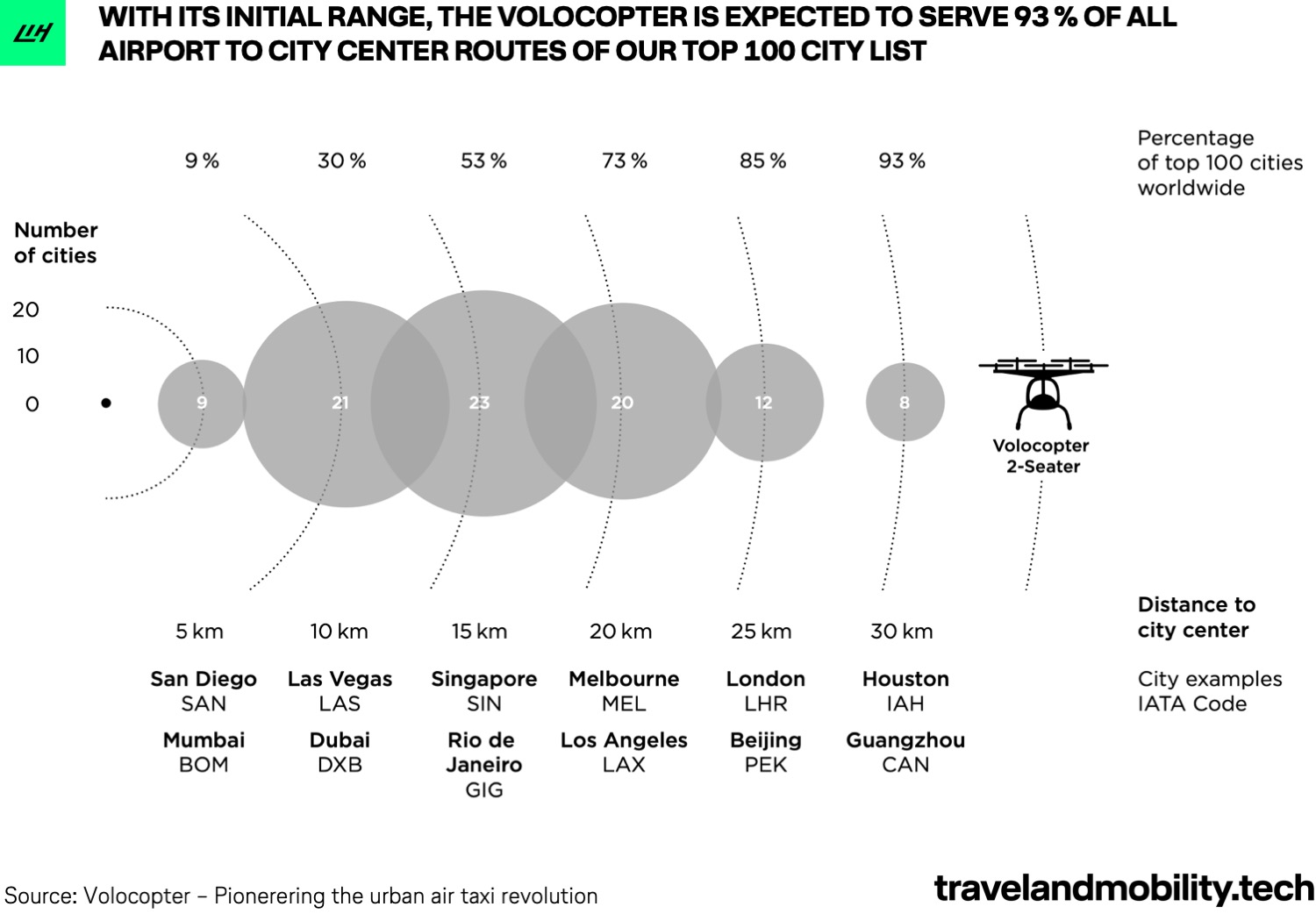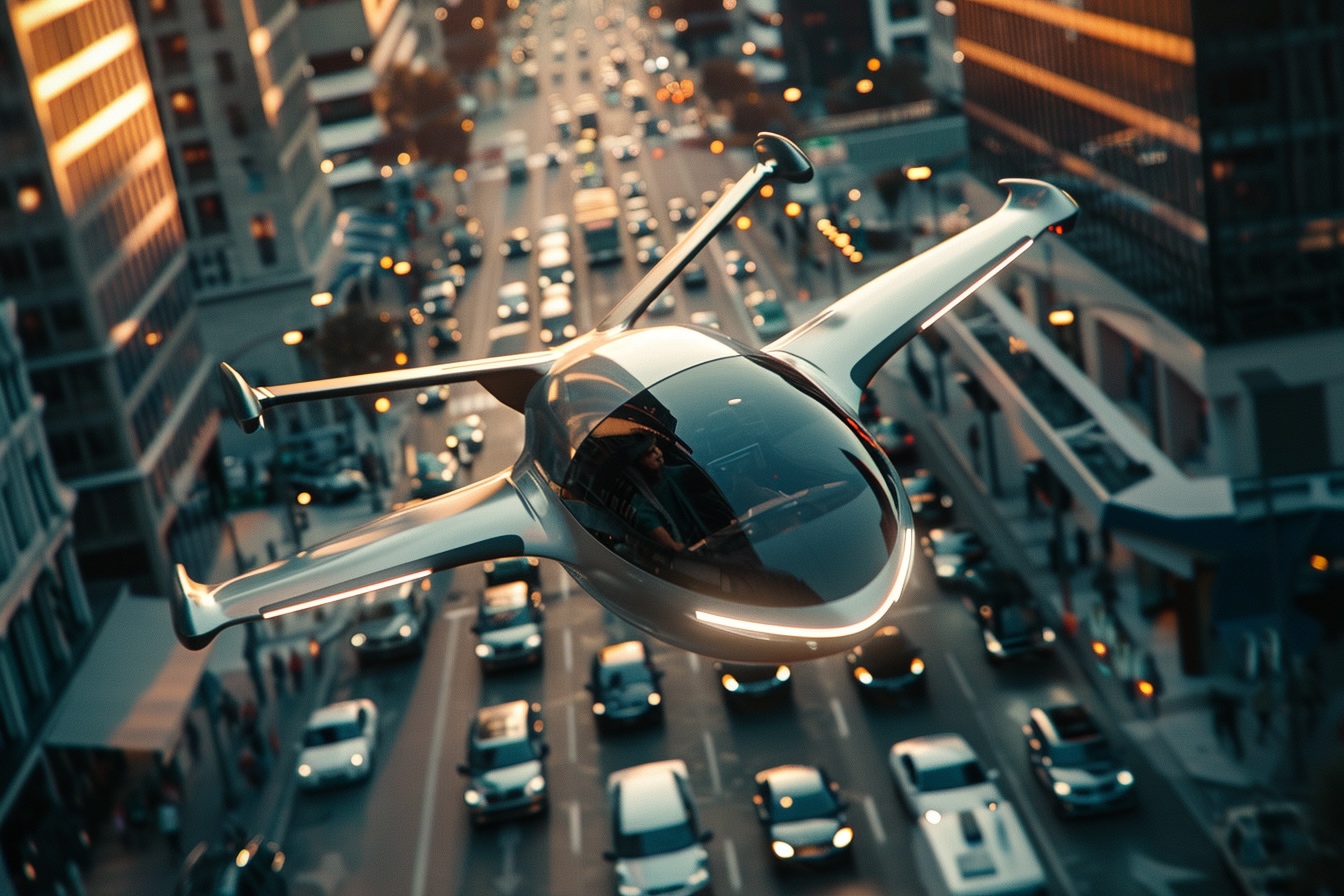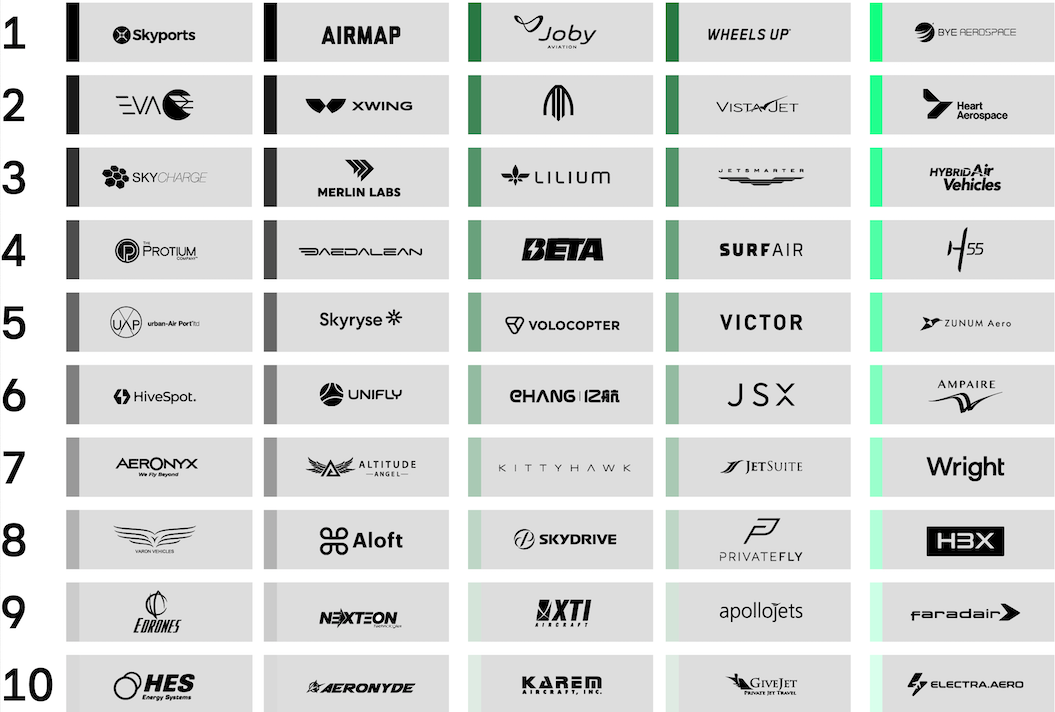The transportation landscape is expanding rapidly with hundreds of startups and a growing number of traditional mobility providers (e.g. automotive OEMs) equipping our cities with new mobility modes to cover short distances such as ride-hailing or car-sharing. Not only that, but these companies are also developing new forms of longer-distance transport, for instance, carpooling and air taxis, to get us from point A to point B more conveniently.
It’s hard to keep track of all these new modalities that have the potential to further change the transportation environment as we know it. Therefore, we present you with a comprehensive overview of 16 major modes within New Transportation ranging from e-scooter sharing all the way to space-travel providers, which may one day allow us to travel to the moon and beyond.
Within each of the 16 modalities, we listed ten exemplary innovation leaders that we consider frontrunners in their respective transportation segments. But first, a short intro to the major trend that is fueling this transformation.
The fragmentation within Transportation
The options people have to move around the urban environment (and beyond) have significantly increased in recent months and years and will continue to expand – at least in major metropolitan cities and their surroundings.
New business models, spearheaded by ride-hailing and car-sharing giants like Uber, Lyft, and car2go, have already altered traditional transport patterns, especially the use of one’s own car. This trend is not expected to fade out anytime soon. Transportation is ripe for further disruption as technological advancements in the form of electrification, connectivity, and autonomy have only partially been unlocked.
To get a more structured understanding of the changing transportation landscape, we segmented the available modes of New Transportation into four overarching categories:
- Micromobility
- Urban Mobility
- Short-Haul Travel
- Long-Haul Travel
This segmentation is based on the average distance that users travel with each of the New Transportation modes. Obviously, there are overlaps between the means of transport and the distances traveled with them. But more and more, each transportation mode addresses one major use case with relatively similar distances to overcome – the most obvious one being Micromobility that focuses on the first and last mile via e-bikes and scooters.
Here is our New Transportation Leaderboard. Click to enlarge!

See the full list in table format
If you are an investor, startup founder, travel analyst or industry expert and would like to learn more about each company listed in our New Transportation Leaderboard, check the below Airtable for additional company details including links to their respective websites and Crunchbase profiles.
Note: a paragraph on our methodology for creating the New Transportation Leaderboard can be found at the very bottom of this article.
Let’s jump into the four overarching categories in more detail and dig into their respective subsegments to make sense of our Leaderboard, especially the average trip distances associated with each New Transportation mode.
Micromobility
The rapid rise of shared mobility—through car-sharing, ride-hailing, and shared public bicycle systems—paved the way for e-bikes and ultimately, e-scooters, responding to the public’s appetite for cheap, convenient, and flexible ways to quickly get around town.
Micromobility startups — including global powerhouses Bird, Lime, Mobike, and Ofo — have emerged as relevant alternatives to the current transit mix. As BCG concludes, scooters and bikes fit squarely into the Micromobility segment as the majority of trips are only a few kilometers long and significantly shorter than with other urban mobility types, such as ride-hailing or car-sharing.
Roughly 35% of all personal trips cover distances of less than 2 kilometers (km) and 75% amount to less than 10 km, BCG found out. E-scooters are typically used for trips from 0.5 km to 4 km, the equivalent of walking for 5 to 45 minutes. In theory, this means e-scooters could be used for a large proportion of inner-city travel. They can also be easily paired with other mobility modes (especially public transportation), thus making them a handy solution for traveling the first and last miles from your home to the train station.
Obviously, the typical distances covered with e-scooters vary by city and country. For instance, in Berlin – one of the top three travel destinations in Europe – average distances tend to be slightly longer (roughly 2.8 km) because a large share of e-scooter usage is captured by tourists who cruise along the city’s major sights.
In general, scooters tend to fit the bill for relatively short distances. Furthermore, they have advantages over other modes: they’re cheaper than hailing a ride-share vehicle, you don’t have to hunt for parking space, and there’s no sweating involved when comparing it to bike-riding. Plus, it’s a lot of fun cruising down the road on what until recently was just a child’s toy that you stand on and propel with your foot.
Urban Mobility
People care about mobility, whether it’s for everyday needs such as getting to work with ease or if it’s a part of their travels – for instance, getting to and from the airport or exploring a new city during a weekend getaway. That’s why Urban Mobility – going beyond quick and short Micromobility needs – has long been ripe for disruption, especially in the context of large cities.
Increasing urbanization and the growth of “megacities” have provided the urgent need for change as traffic is getting worse in most major metropolitan cities around the globe. McKinsey calculates that from 2010 to 2016, congestion rose in London by 14%, in Los Angeles by 36%, in New York by 30%, and in Beijing and Paris by 9%.
Congestion not only implies productivity and financial losses, but it also causes higher stress levels, carries serious health consequences, e.g. in the form of accidents, and results in critical amounts of air pollution.
Today, only a very small number of major cities, arguably Amsterdam, Singapore, and Stockholm, are singled out as having effective mobility systems in place. Far too many urban residents and tourists in other cities around the globe regularly spend hours stuck in traffic. Unlike Micromobility services, New Transportation solutions addressing the Urban Mobility arena focus on slightly longer trips than what is convenient to travel via bike or scooter.
Motorbikes
Sitting just at the border between Micromobility and Urban Mobility are shared motorbikes. They are most often called mopeds or scooters in Europe and Vespas in the U.S. (with Tuktuks and mopeds in Southeast Asia being a closely related species). These typically cover slightly longer trips. Usage data in Berlin suggests average distances of around 5 to 6 km per trip, making it ideal for urban travel that isn’t quite suitable for e-scooters or bikes.
Ride-Hailing and Van-Pooling
Currently, the most popular form of New Transportation in urban areas is ride-hailing. Data on Uber, the earliest disruptor in this sector, shows that the average trip distance is around 10 km. As ride-hailing services continue to expand to serve suburban areas outside city centers (especially in the U.S.), the trip distances tend to increase. Most ride-hailers these days also offer a pooling option that allows passengers to join other users with similar routes on the same trip and to share the cost of the trip. Thus, the average distance per user tends to be moderately longer. Several specialized operators – most of them using vans or small buses – have focused on this niche within ride-hailing. Such multi-person transportation solutions have huge potential, especially in yet untapped commuter neighborhoods and employer hubs.
Car-Sharing
Car-sharing, mostly known via global operators such as Zipcar, car2go, and DriveNow (the latter two now merged into ShareNow) typically covers trips of similar distances to ride-hailers and is “well-suited to spontaneous one-way trips of less than 15 minutes”, as BCG concludes. But it’s also increasingly being used for outside-city trips to airports, covering slightly longer distances averaging around 14-17 km in many places.
Unlike ride-sharing, it does come with some tangible disadvantages such as parking constraints and the fact that you need to get to specific access points unlike ride-hailing, which can be called to your exact location.
Autonomous Cars
When it comes to longer driving distances, autonomous cars have the most potential to make traveling a lot more pleasant. Passengers are able to spend their time in the vehicle productively and there is no need to engage drivers, who bring about costs and travel constraints (fatigue, working hours, etc).
According to 2018 data from the California DMV, Alphabet’s Waymo drove 11,254 miles (roughly 17,950 km) per disengagement – the moment when the vehicle is taken over by a human driver as the software or accompanying human detects a failure. This proves that the technology behind autonomous vehicles (AVs) has progressed hugely in recent years, even if it’s still by no means perfect. Certainly, AVs have the potential to be used for anything from urban to intercity or cross-country trips – therefore, making it hard to match one specific use case to this category. But as the technology is still in its early testing stages, it will most likely initially be applied in ride-hailing formats with a human back-up driver as safety support behind the wheel and serve urban needs before it covers intercity trips. Waymo’s self-driving ride-hailing offerings in selected U.S. cities support this hypothesis. Other examples are van-pooling use cases (e.g. EasyMile and Optimus Ride) which already operate autonomous pick-up services in several areas.
Hence, ultimately, the autonomous-car category must be considered a horizontal technology layer that will span across various New Transportation segments in the future.
Short-Haul Travel
When traveling outside the urban environment, the disruptive power of New Transportation services is less advanced compared to the inner-city landscape.
While transportation options from trains to airplanes exist, the choice is often more limited and costly. As a result, the sharing economy has huge potential to gain a lasting footprint in the short-haul travel segment, e.g. via carpooling a la BlaBlaCar or Flixbus for the bus segment. In fact, dozens of players from the corporate and startup world are developing alternative transportation solutions that will expand the choice of modality to travel around the country.
Within Short-Haul Travel, there is a large range of different distances covered depending on the country or continent. In Germany, the average stretch covered by passengers in long-ranging buses, for instance, was around 310 km in 2017 according to Statista. In contrast, bus trips in the U.S. tend to be way longer, which is expected given the size of the country.
Three New Transportation modes within Short-Haul Travel are particularly interesting to look at in more detail:
Car-Pooling
In Europe, car-pooling journeys average 200 km (about 2 hours) with BlaBlaCar leading the pack at 342 km per trip, which is just about the distance between Vienna and Prague. The primary limitation for car-pooling distances may be how long people are willing to travel in a car with strangers. So far, the market outlook is bright with car-pooling boasting average annual growth rates of >15% until 2025 according to latest market forecasts.
Air-Taxis
A novel service in the transportation marketplace, air-taxis are aimed to offer speed to those who’d rather get to a place faster by circumventing traffic on the ground. Lilium, an electric air-vehicle startup from Germany, recently showcased its “flying taxi” with an expected range of up to 300 km. Uber Copter, the helicopter service from Uber, launched its operations at New York’s JFK this summer, carrying passengers from the airport to the city center in 8 minutes. This is step one in Uber’s larger Elevate vision, in which the company aims to extend its existing ride-sharing offering via air transportation in eVTOLs (electric vertical takeoff and landing vehicles).
While evidence of functional air-taxis in fully electric form is yet to come, discussions among industry experts regarding the most viable use cases and the required range of an eVTOL for the urban air taxi mission are in full swing. Volocopter – another highly promising German air-taxi contender – recently predicted that their types of travel solutions would serve an area of 30 km on average, which is the distance from the airport to the city center in most megacities – see this excerpt from their latest report below.

Uber originally stated, as part of its 2016 Elevate whitepaper, that existing commuting practices suggest a minimal effective VTOL range in the near-term of 50 miles (roughly 80km). Air-taxis would mainly be useful to so-called “mega commuters,” people who commute around 160 km per day (80 km to and from work). During Uber’s latest Elevate conference in May 2019, comments indicated that the ride hailer has switched to Volocopter’s point of view, accepting that the inner-city use case will most likely be the first to be addressed.
Hyperloop
Another potential entrant in the New Transportation space and still in the early R&D phase, the Hyperloop, doesn’t have real-world data yet as the underlying technology is still being developed and commercial viability is not yet determined. Yet the first most promising routes currently being suggested have average distances of >300 km.
If implemented at a large scale, Hyperloop technology will likely be a major disruptor in the Long-Haul Travel sector as well. The potential is especially big in the U.S., where the railroad system is less advanced than in Europe.
Long-Haul Travel
For long-haul distances, for instance, when traveling across the Atlantic for a business meeting or summer vacation, the traditional airline product will very likely continue to maintain its pole position. Nevertheless, even within this segment, new technologies (e.g. supersonic flying and electric propulsion), as well as shared business models (e.g. in the form of an Uber model for private business – see Wheelsup), have the potential to capture a piece of the cake in the mid-term future.
As most technologies in this sector are still being developed, we looked at the predicted maximum ranges for the different modes in order to map them accordingly in our Leaderboard. For example, electric jets are expected to have maximum ranges of around 1100 km due to battery density constraints, with supersonic planes averaging up to 10,000 km according to announcements by major manufacturers.
Electric Jets
Multiple companies are aiming to develop electric aircraft that could change our skyways and limit the carbon emissions emitted into the atmosphere. Eviation, an Israeli company, is working on a prototype that would apparently fly around 1,000 km. Zunum Aero, long considered the most promising challenger in electric flying – and also backed by Boeing and JetBlue – was seeking to debut a prototype in 2020 that would fly a range of 1,300 km. However, this aspiration appears to have come to an end, as Forbes recently reported that the company stalled operations while Zunum’s founders are desperately looking for new funding.
Supersonic Flying
Lastly, we have what has been perhaps the most-debated technology in the aviation context for decades, the supersonic aircraft. As those who remember the Concorde will know, this is not a new technology per se, but it is headed towards a major comeback, with entities like NASA developing the tech and the U.S. Congress about to remove its ban on supersonic flying.
These aircraft aim to travel astounding distances at unprecedented speed, averaging 9,850 km give or take. For example, the Boom Supersonic Airliner would have a range of 8,300 km while Spike S-512, proposed to be the world’s first quiet supersonic jet, could see a max range of 11,482 km.
What’s next: New Transportation 2.0
The Travel & Mobility Tech sector is going through massive changes (check out our report on the State of Travel & Mobility Tech). The fragmentation of the transportation landscape has been one of the main trends in recent years. Growing urbanization and traffic congestion increasingly challenge existing mobility systems, raising demands for dynamic and multimodal mobility solutions with greater interoperability among different modes of transportation.
The major challenge the industry is facing, then, is how to connect all these silo services so that users’ smartphones (especially of those living in major cities) stop being flooded with way too many mobility apps. Fortunately, more and more startups are either building provider-agnostic solutions or helping existing mobility and travel services to better connect with each other through a much-needed underlying tech backbone.
Keeping this in mind, it’s possible to envision a future of “seamless mobility” with a continuous flow of options among the entire New Transportation landscape available to the user.
In such an environment, the boundaries among the 16 different New Transportation modes would increasingly be blurred. McKinsey suggests that such seamless mobility could have the benefits of being significantly cleaner, more convenient, and more efficient than the status quo. Additionally, it could accommodate up to 30% more traffic while cutting travel time by 10%.
These new mobility-as-a-service concepts make it challenging for traditional travel providers – whether airlines or vehicle OEMs – to maintain control over their relationship with the end-user. Therefore, it’s crucial to keep a close eye on all these new New Transportation offerings and develop strategies to actively engage and expand one’s services along the transport chain.
Methodology
The selection of companies is our best-educated guess of exemplary innovation leaders in each New Transportation category. We gathered information from public data sources (e.g. company registers, company reportings, press releases), subscription-based financial databases (e.g. Pitchbook, AppAnnie, Crunchbase, Similarweb) as well as via our very own deal flow to feed our point of view.
The New Transportation Leaderboard not only contains startups but also corporate-owned subsidiaries that provide New-Transportation products and services, as long as these corporate-owned programs operate with a perceived level of independence and autonomy as in the cases of Sharenow and Waymo.
Our definition of New Transportation contains those transport providers that have been launched within the last 12 years since the emergence of the smartphone. As a consequence, traditional transportation providers – which increasingly adapt their transportation offerings to cater to the digital and mobile era, e.g. car rental companies Hertz, Avis and Sixt as well as automotive companies working on autonomous driving technologies (incl. Tesla) – have been excluded from our New Transportation Leaderboard.
We made an exception within the Supersonic Flying segment, as it would be misleading not to list traditional incumbents Boeing and Lockheed Martin in their pursuit of developing supersonic aircraft. We agree that certain categories could be challenged in terms of their New-Transportation character, for instance, the bus segment. Here, Flixbus and others have “only” executed a digital renewal of an already existing industry. However, the digital savviness, speed and asset-light approach by which this has been done is outstanding and deserves a dedicated segment in our infographic.
Nevertheless, we do not intend to provide an all-encompassing list of providers in New Transportation, nor do we intend to offer a leaderboard based on fully objective, quantitative criteria. The ten providers chosen in each category are selected based on our subjective expert opinion. We believe to have a close view of the industry as we engage with countless Travel & Mobility Tech stakeholders on a daily basis.
However, we are aware that our company selection is most likely biased towards transport providers from the Western hemisphere, as the deal flow and company information we analyze on a daily basis are unconsciously affected by a home bias. The same refers to our existing investor and startup relationships. Lastly, the transportation landscape is increasingly characterized by local players as transport preferences and habits as well as regulation differs between local markets. This is the case with e-scooters even between cities in the same country. Our New Transportation Leaderboard emphasizes those players with an international, if not global ambition.















